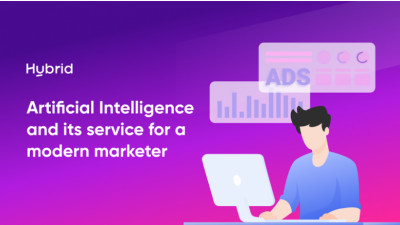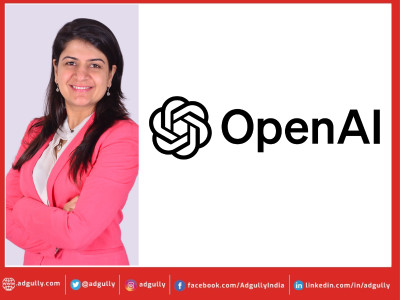Artificial intelligence in the service of a modern marketer
Innovative advertising formats that use AI to operate are now becoming extremely important. Such solutions include In-Image Ads and Semantica 360° from companies like Hybrid AdTech have become more and more popular as an alternative to the upcoming post-cookie era.
AI (artificial intelligence) is a broad term and covers the area of technologies inspired by how people solve various problems in the real or virtual world. For example, as humans, we solve problems in such a way that we go through a learning process, adaptation to new conditions. It can go two ways: either we receive precise step-by-step instructions or we learn by observing. To illustrate this, imagine that you are in a room with different and unfamiliar cultural and social norms. You don't know how to behave, but you want to find out. Therefore, you observe people around you, and on this basis, you start to pigeonhole various behaviors. By observing what others are doing, you adapt to the environment and new conditions. This is the method used by artificial intelligence - it observes the input data, how they behave, what happens to them and how they should be classified, and then catches various dependencies and correlations that exist between these data.
AI is an interdisciplinary field to create solutions in the terms of artificial intelligence, techniques and knowledge, not only in the field of computer science and programming but also cognitive psychology, methods of remembering and processing information, linguistics, mathematics, and statistics.
The main assumption of AI-based solutions is that the algorithms find dependencies between the received data and independently learn how to solve a specific task. There is one problem with this scheme - currently, we do not fully know how AI solutions built in this way come to specific conclusions based on the received data, the so-called black box problem. However, scientists are already working on solving this problem.
Machine learning, deep learning, and neural networks
The concept of machine learning is inextricably linked to artificial intelligence. It means a concept in AI where algorithms and programs learn and develop on their own based on data without the need for further human intervention. Thanks to this, they can solve increasingly complex problems and issues on their own.
Deep learning and neural networks are used to create such self-learning solutions. These networks are built based on the human nervous system and are designed to reflect the behavior and operation of the human brain. Data is key to deep learning algorithms. The more we provide them, the better and faster they will learn and become better at the tasks set before them. The same as with people - the more examples of a solution to a given problem we receive and the more we practice, the better we become.
The development of AI has accelerated significantly
Artificial intelligence is not a new concept, and the beginnings of work on it date back to the early 1950s. It was then that Alan Turing, a British mathematician, and cryptologist co-responsible for the development of the Enigma-breaking device, created the well-known Turing Test. It aims to determine to what extent communication with a machine resembles that with a human. This test became extremely popular and is still used today.
Since then, work on artificial intelligence has started in many research centers and enterprises, which led to the creation of the first major solutions used in medicine in the 1970s and 1980s, as well as within the so-called expert systems, i.e. systems supporting the work of specialists, which translated into increased efficiency of business activities.
The further development of artificial intelligence in the 1990s brought more and more advanced solutions used in various fields, and AI itself became a bit louder, e.g. Deep Blue computer won in 1997 in a chess game against the world champion Kasparov. In the later 2000s, however, deep learning and neural networks began to be used in AI solutions, which greatly influenced the possibilities they offered.
Currently, research on artificial intelligence and its development has gained even greater momentum. There are more and more innovative solutions that are based on AI and are used in various fields, both scientific and commercial. Many of them are created and used in the marketing industry. Companies creating such advanced AI tools for the advertising industry include international adtechs Hybrid and VOX. They develop proprietary technological solutions using picture recognition and computer vision.
Original advertising formats based on AI from Hybrid and VOX
Picture recognition and computer vision are technologies fully based on artificial intelligence and deep learning. They enable a thorough analysis of graphics and photos, as well as the recognition of objects, people, animals, symbols, texts, etc. on them. The image recognition algorithms used can do this with a precision equal to that of a human, or even better.
In order to recognize objects in the image, the algorithm carefully analyzes it, determines and describes its features, including the features of all elements present in it. It then assigns the image and its elements to specific categories based on the previously described characteristics.
For picture recognition and computer vision technologies, databases are extremely important, on the basis of which the algorithm assigns the examined object to a specific category, e.g. people, cars, shoes, books, computer, etc. They contain detailed descriptions of specific groups of objects in the form of separated common features specific for these categories. Thanks to this, the algorithm, after describing the examined element in the photo, can determine which group of objects it is closest to and assign it to it. Due to the use of deep learning and neural networks, the created algorithms develop independently on the basis of the data provided to them. Thanks to this, the possibilities they offer are constantly expanding.
Using picture recognition and computer vision technologies, VOX has created an innovative In-Image Ads advertising format, which is a new model and advertising placement on desktop and mobile. It consists in the dynamic display of advertisements in photos in materials on publishers' websites. The In-Image Ads format is based on proprietary algorithms that carefully analyze graphics and photos, and then recognize the objects on them, including objects, products, brands, people, animals or symbols. Thanks to this, contextual targeting and matching of the displayed advertisement is possible.
The computer vision technology is also used by Hybrid in the company's latest solution - Semantica 360°. It uses artificial intelligence algorithms and computer vision to recognize text, images, video and audio, which allows for accurate and comprehensive analysis of the entire content of the page. Thanks to this, it is possible to target more precisely, find the target group easier and achieve better results of the advertising campaigns.
Both the In-Image Ads and Semantica 360° formats are ideal alternatives to the upcoming post-cookie era. At the same time, they are characterized by an extremely high CTR rate, as well as ensuring 100% brand safety and viewability. If you want to learn more about them, together with other solutions offered by Hybrid and VOX, please check more information on the Hybrid and VOX websites.



















Share
Facebook
YouTube
Tweet
Twitter
LinkedIn